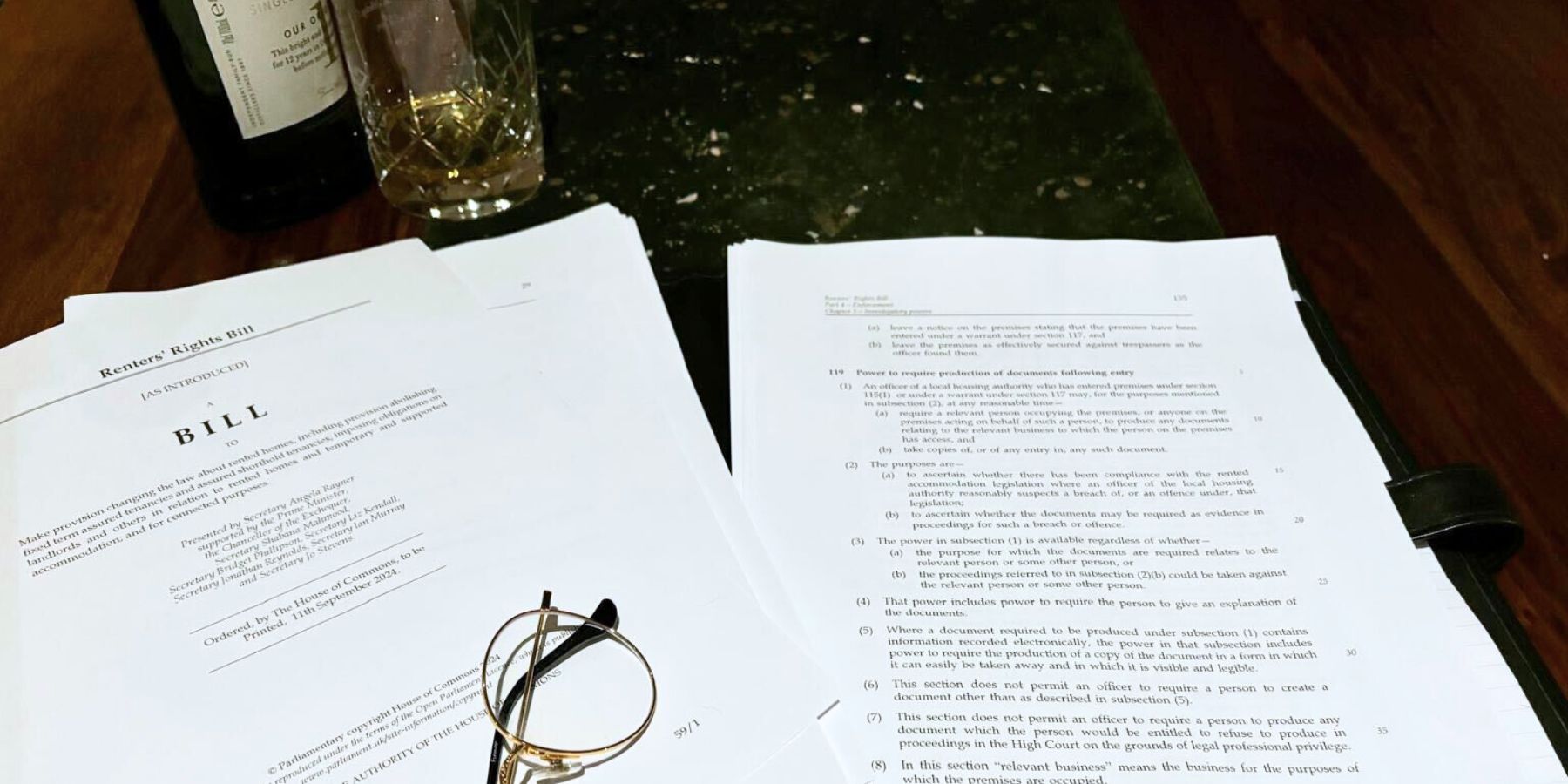Renters Rights Bill – What is says, and what it means
12th September 2024

Yesterday, the Renter’s Rights Bill was released by Parliament. This is the first written iteration of the long expected bill under the new Government. Previously the bill had been put forwards by the Conservatives, then revised, and finally scrapped due to having insufficient time to pass after the calling of the snap election. So beyond changing the name from a “Reform” bill, to a “Rights” bill, what differences are there to the contents, if any? and what are the key points and the potential effects to the sector? I have read all 216 monotonous pages, so you don’t have to!
Banning of Section 21 Notices (A revision of the 1988 Housing Act)
Ok so, not surprise there. The end of S21s has long been the headline of the bill, and it’s clear to understand why. Labelled as the banning of “no fault evictions”, it’s easy to imagine the spirits of renters being stirred!
S21 has long been seen as the most efficient way to end a tenancy that is not in a fixed term. In practice, an overwhelming majority of S21 evictions are in fact not “no fault” and instead are used by Landlords in the event of problem tenant who missed rental payments or caused destruction of property. Both of which are grounds for a Section 8 notice, and eviction via the courts, but which takes far longer than the two months’ notice needed in serving an S21. It could be rightly argued that problem tenants have benefited from how painful and long the S8 process is seen to be, instead being released from the tenancy under a section 21, with no penalty.
Fundamentally this change should not shake up the sector to any great degree in the longer term. Landlords who have reasonable grounds to evict a tenant, including rent arears, destruction of property, and changing the use of the property (such as moving in yourself, or selling) will still be able to do so by use of a Section 8. The biggest question here has always been, and remains, how the courts will handle the increased number of S8s. The Conservatives previously conceded that the court system would equally need to be reformed before the banning of S21s, but there so far seems to be no similar statements from Labour.
Tucked away, almost silently, within the bill is a change to the specific repossession grounds for rental arrears. Previously a tenant would need to be in arrears of 2 months in order for the Landlord to have the right to re-possess. This has now been extended to 3 months. Once this small tweak is more broadly identified and hits the news, it is likely to go down a treat in a period of excessively high buy-to-let mortgage costs. Usually, I would expect absolutely no mercy from Lenders, with no grace period allowed on mortgage payments where a Landlord is not able to cover payments due to a problem tenant. However, I will be fascinated to see whether repossession numbers in the BTL market change in future years. Where a Landlord cannot cover costs due to a tenant not paying, will Lenders be so keen to re-possess a property, and themselves inherit an asset with a squatting tenant and now restricted powers to move them along…?
Importantly, if re-possessing on the grounds of the Landlord selling or moving in, at least 12 months must have passed since the start of the tenancy.
Ultimately, this change should not be a huge issue for Landlords, and a few tenants will no doubt benefit in the case of rouge Landlords who do use S21s unfairly. However, those benefits will all be in the long term, and the short term it’s going to be nothing but bad news for many renters. With the Bill expected to pass royal assent and come into force in Summer 25, we can no doubt expect a rush of Landlords serving S21s before then. I already have an article title ready for a years’ time …
“Record Numbers Of No Fault Evictions Caused By Government Banning No Fault Evictions”….
An End to Fixed Term ASTs (Assured Shorthold Tenancies to revert to Assured Tenancies)
Again, we knew this was coming. Again, the logistics where always the question and concern. This change had always confused me though. Fixed terms offered security and comfort for tenants. From the point of moving in, there is clear line in the sand to state when the tenancy would come to an end, unless mutually renewed, or mutually ended sooner. All parties enter knowing this, and tenants are safe in the knowledge that they have until this date and cannot be wrongfully evicted in the meantime. Fixed terms also limited regular and unfair rental increases. They allowed for a yearly discussion between Landlord and Tenant about continuing, confirming all parties are happy and re-agreeing rental terms before entering into a further term. In my own mind, fixed terms should have been rolled out as the preferred method of tenancy, and instead periodic agreements removed… but each to their own…
One of the biggest concerns on the removal of fixed terms has always been in relation to seasonal tenancy types. My own intrigue is likely higher than most on this point, given I work within a Sales and Lettings agency that specialises in HMO properties, specifically for student Tenants and Landlords. So, you’ll have to forgive me for focusing on this market specifically…
Importantly, as the Conservatives had also conceded, provisions have been made for Student tenancies. The Bill outlines that a Student Tenancy can still be a fixed term, but only in specific instances and with a few extra hoops to jump through. Where all tenants in the property are full time students when entering into the agreement, a fixed term tenancy can be used, but only where the end date is confirmed as a separate notice and document issued prior to signing the tenancy agreement.
The property must also be an HMO. So smaller properties of 1 and 2 bedrooms that target the student market will not have these same rights. This should be of only minor consequence though, with smaller properties having appeal still to alternative tenant demographics. It might just mean a change in strategy for some Landlords.
A notable omission from this section of the bill is a definition of an HMO. Will this rule cover properties deemed to be an HMO in a licensing sense, or a planning sense? As these two categories are often quite different. If it is on a licensing basis, does this also include where local authorities implement an Additional Scheme, or will it just apply to properties that are National HMOs (5+ bedrooms). Potentially a technicality and seemingly a small oversight to not confirm this now, however sadly this reinforces the consensus that the bill has been released without full and clear consideration for the nuances of the private sector.
Cue a collective sigh of relief from Student Accommodation providers and agents across the country.
This ensures that student properties can be repossessed each year in the summer, and avoids tenants staying on past this time, into Oct/Nov when the property would then not re-let as the academic year will have started. I really hope to be corrected, but from what I can infer, the fixed option to re-possess at a pre-determined date is only on the Landlord’s side. This date is the only date on which the Landlord has the right to end the tenancy, but the tenants will still be able to serve notice to quit any time before then. In effect, It is not a fixed term agreement, but a periodic agreement with a Landlord exit clause.
…and so, one of the largest concerns for Landlords and Agents remains. A tenant could still choose to leave the property mid-way through an academic year, when re-let options for the will be minimal, and in all likelihood, they will be landed with an empty property until the following summer. The only quick way to assure income would be to source an alternative tenant type, but a short agreement covering just from the void date to the next student season is not possible… So, what will this actually look like in practice?
I have long theorised that one partial solution for Landlords is to insist on individual tenancy agreements. Where students have their own contract to their own room. Thus, the damage of a tenant leaving is limited to potentially just that single tenant or two, as opposed to an entire joint AST being scrapped because Timmy has fallen out with the rest. With Individual agreements, Timmy can now leave when he wishes, and the Landlord only loses one portion of rent, as opposed to the entire household’s rent. One downside to this though is tax. Council tax, on HMOs in particular, has been in the spotlight recently, with the approach by most local authorities now shifting so that on joint agreements, the tenants hold liability for council tax. On individual agreements, the Landlord holds liability.
The response therefore is obvious. Rents will increase. Rents will rise so that Landlords can whether a mid-year drop out, should it arise, and also to cover increase costs in tax. Again, I have my Article Title ready…
“Rents Rise To Unaffordable Levels Thanks To The Government Protecting The Rights Of Renters” …..
A limit to be set for in tenancy rent rises
A limit is to be set of a single rent rise per year. The bill also states that rises must be in line with market levels, also promising improved rights for tenants to challenge unfair rents. The assumption here is that where a Landlord proposes a rental increase, and the tenant disputes, the fair market rent will need to be determined by a third party. Given the Government seems to despise Agents just as much as Landlords, I’m not expecting to suddenly be drafted in to confirm fair rent levels. Instead, reading between the lines, this is presumably the job of the new Ombudsman that is to be introduced as part of the bill. I cannot help but shiver at the thought and irony of a third party, likely dwelling in a Government funded building in London, dictating what an accurate or fair rental level is in a city or town that the valuer has never been too… this is an element of the bill that will need to be watched quite closely as more details are released about just how they plan to implement the change, and importantly their justification on how this is actually an improvement to “fairness” in the sector….
“Ombudsman Dave, Born and Bred In The City Of London, Determines Fair Rental Level For Two Bedroom Bungalow in Newbiggin-by-the-Sea, Overruling Local Landlord Who Now Cant Cover Mortgage”
Extending Awaab’s Law
Very simply, Landlord’s will be set firm deadlines for the handling of identified hazards within homes. Again, presumably handled and policed by the new ombudsman. In principle, I take no issue with this, and neither will most Landlords who provide quality accommodation. Again though, implementation and how this will be judged will be vital.
“Hello Mr/Mrs/Mx Landlord. Your tenant who has persistently dried wet laundry in the home, taken 5-hour long showers, smokes persistently, all whilst having all extractor fans turned off and having never once opened a window; has now raised a complaint against you for condensation damp in the property… you have 10 days to resolve or be fined £7,000”
… surely not… right? Lets see how this works…..
The creation of an online register for Landlords
Moving property compliance and safety checks into the 21st century seems to be an obvious and expected move. A GDPR nightmare, but otherwise sensible. Landlords will be logged along with evidence of holding the required safety certificates for a home. So long as this database remains factual, and contact details hidden, there seems no harm here and only positives. If though this descends into becoming a TripAdvisor-esc website to review a Landlord, chaos will follow. Otherwise, the worst effect of this is that the Landlord can expect an influx of letters sent from Agents, Plumbers, Electricians and EPC Assessors, looking to pitch their services as the register states your certificate is due to expire soon… I’m going to get to work on drafting my own such letters ready…
Whilst not detailed in the bill, discussions directly with ministers seem to suggest that the site will not be a review platform. Instead, other than a register for compliance, the only references to a Landlord’s quality will be a black mark against there name, where a dispute has arisen via the ombudsman.
So, there we are. The Bill is out in the wild once more. What happens next? Well in terms of timescales it is predicted that the bill will come into effect in late spring/early summer 2025. Following royal ascent. There will though be a second reading and a chance to amend. In the second reading under the Conservative government, changes were made, and largely for the better. Mostly in thanks of lobbying from organisations such as the NRLA. In this political cycle and new Landscape, changes may be less likely this time around owing to the large majority on the benches. Instead, amendments will be reliant on in-house disputes within Labour.
Reportedly there are more private sector Landlord’s within Starmer’s party than there were in Sunak’s, so its not impossible some elements will be watered down. Not impossible, but still unlikely. For me, the fact that the bill is no longer titled as a bill of “Reform” and instead a bill of “Rights” indicates that there is no longer any attempt to pretend the changes are being made for the benefit of the sector as a whole, but purely for renters.
The main frustration is that there are clear and obvious ways each change will worsen the situation for many renters in the UK. As a Sales and Letting agent, but one who personally lives in rented accommodation, I believe I can give an honest and impartial view, with a foot in both camps, and my key forecasts on how the sector will change on a macro scale are:
- Rents will rise
- A record number of no fault evictions will take place before Summer 2025
- Supply of rental properties will decrease, limiting options, increasing competition
- Tenants who otherwise may have left peacefully under a S21, will now be evicted under a S8, with court intervention, and face financial penalties
All in the name of Tenant Rights…..
Adam Coffin MSci, MNAEA, MARLA
Private sector property expert and perpetual cynic.

Autumn Budget 2025 – Key Property Points
31st October 2024
As the UK grapples with a severe housing shortage, will new tax policies and a £5 billion spend pledge be…

Employee of the Month – October 2024
16th October 2024
Our employee of the month for October is our Head of Finance – Kayleigh Beal! Kayleigh works extremely hard, with…

House Prices and Consumer Confidence
11th October 2024
Despite the September fall in consumer confidence, levels remain well above the lows of 2022. This recent faltering is likely…